This online exhibition features multiple viewpoints of exemplary 1:12 scale furniture and accessories, showing off the artistry involved in making each piece. Mrs. Kruger selected her miniature furnishings one by one, spending years collaborating on individual pieces with artists. Perfecting room displays would take a decade, refining the “story” of each room and finding those perfect pieces to tell that story. Most of these objects were made by Eric Pearson, whom Kruger employed for the majority of her special commissions. Not only does his craftsmanship stand up to the discrimination of macro photography, but his objects also tell the story of Eloise Kruger’s collecting style in a way that cannot be matched.
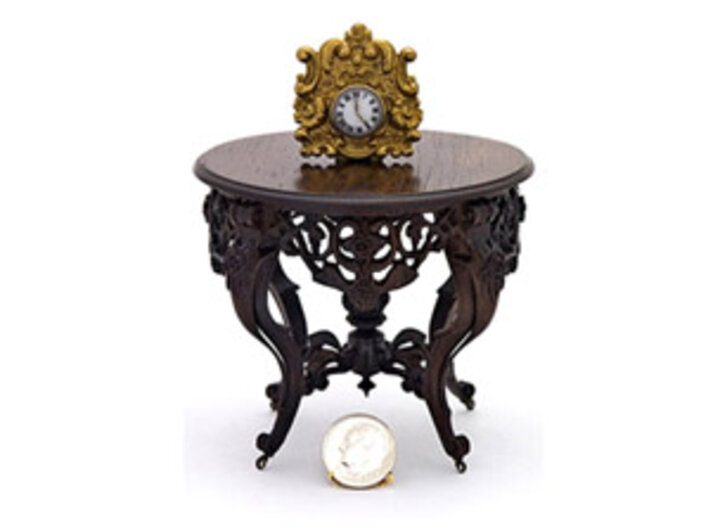
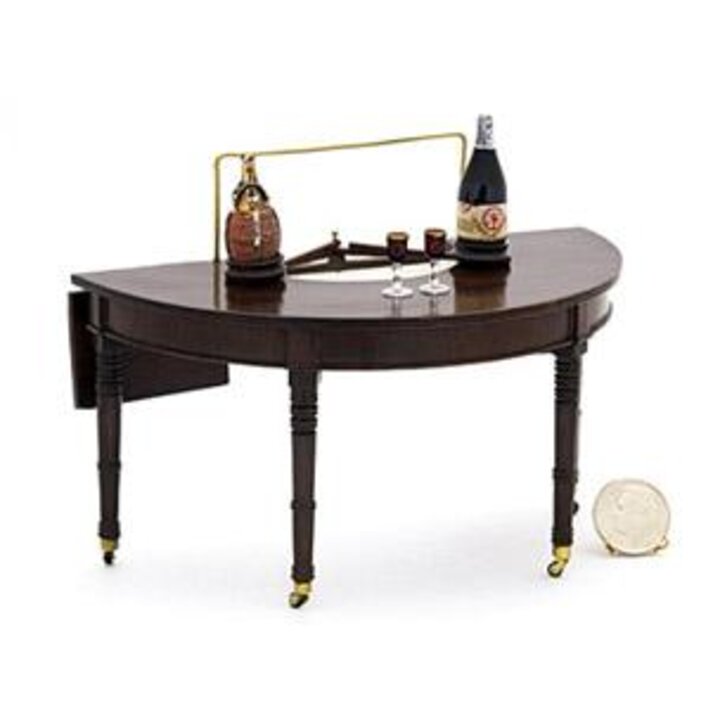
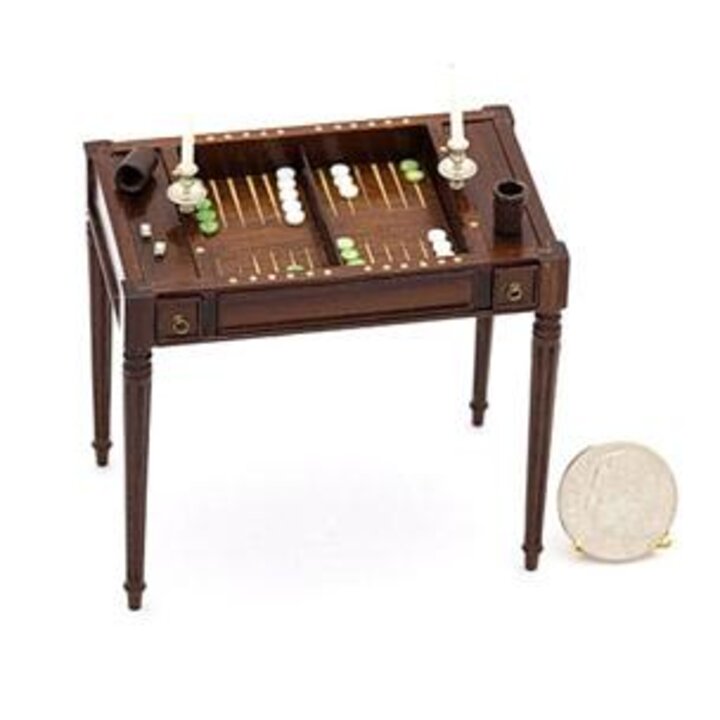

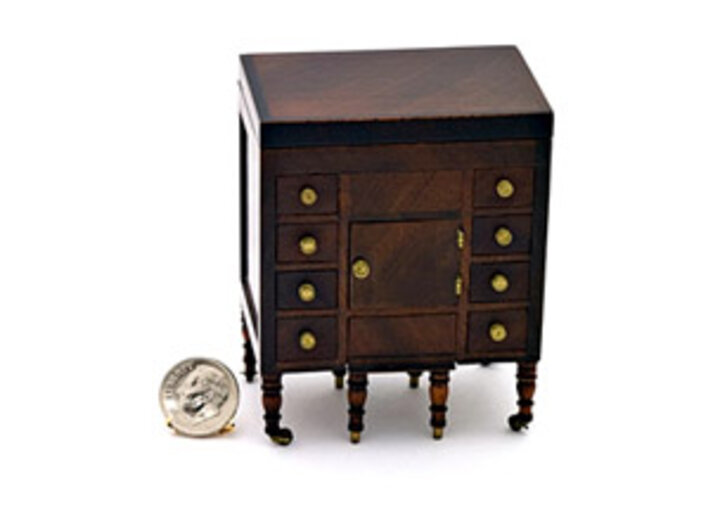
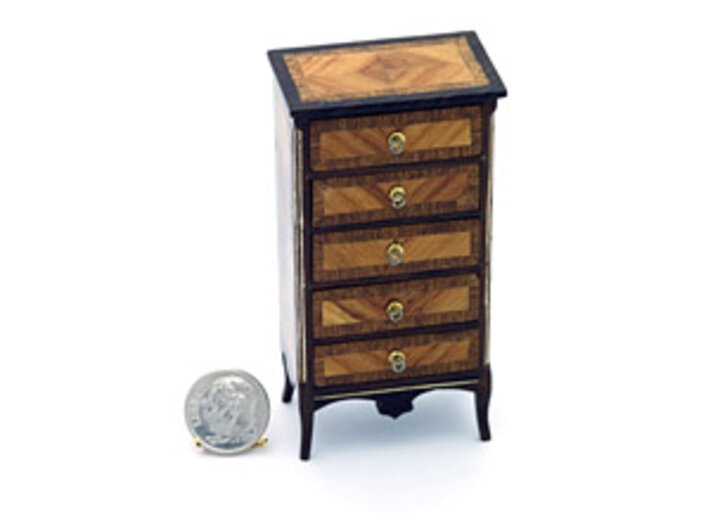

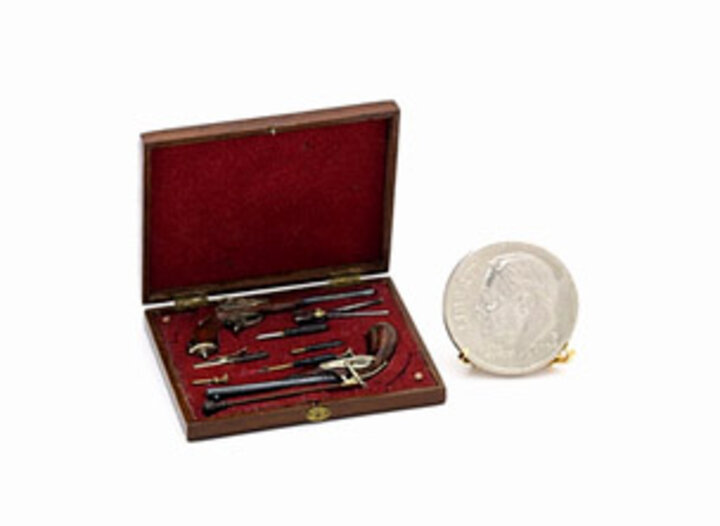
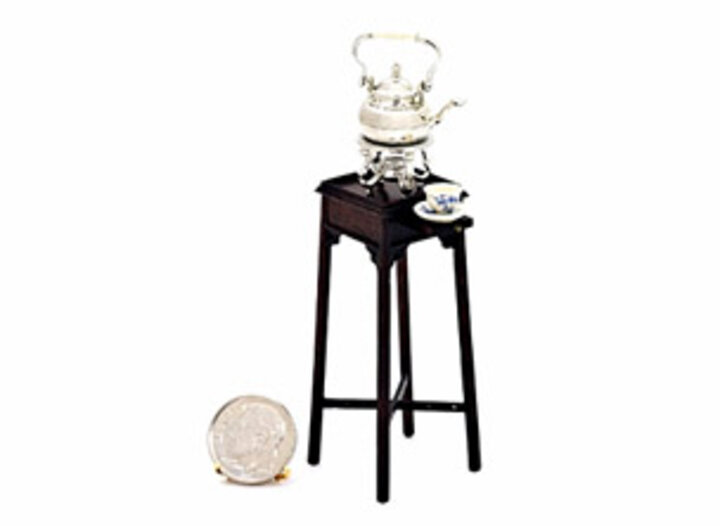
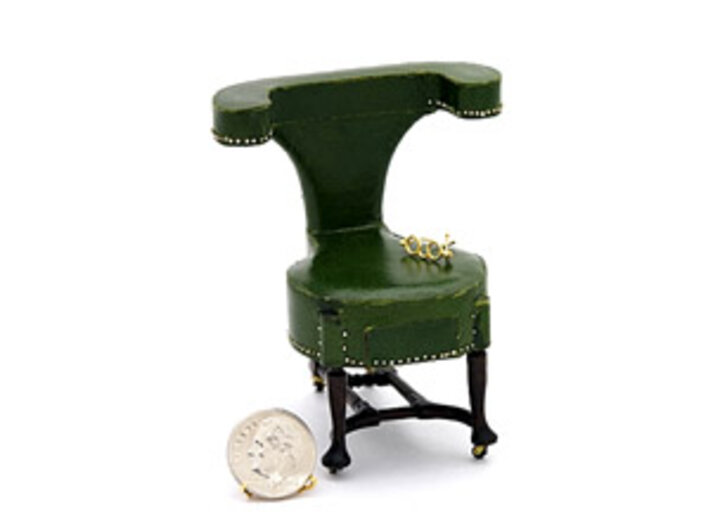

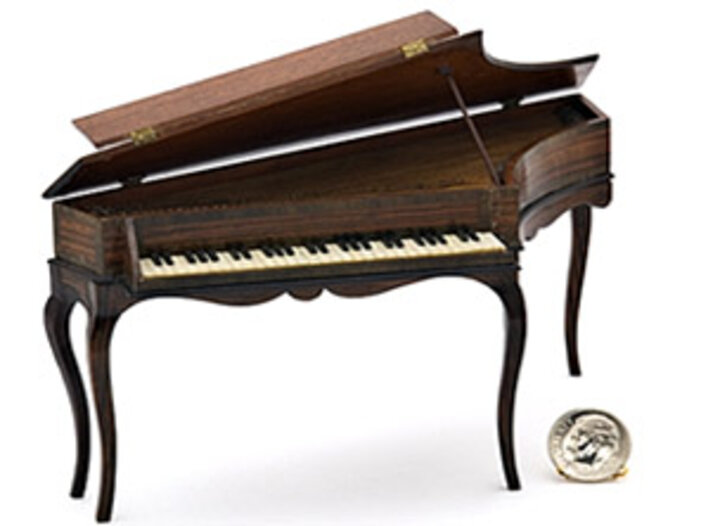
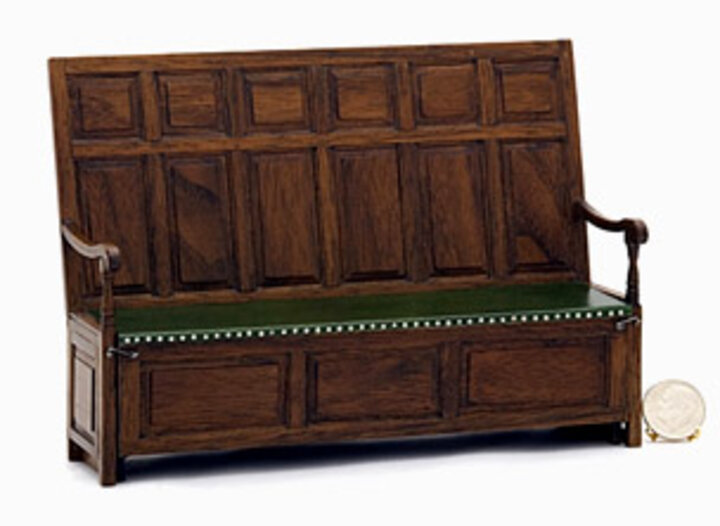


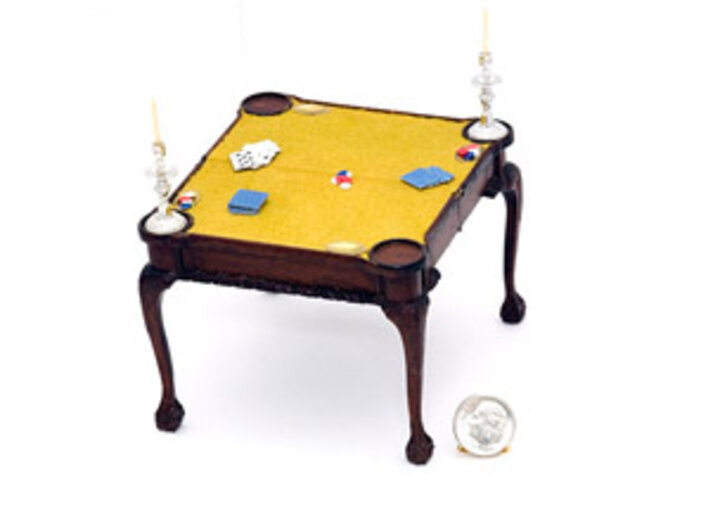
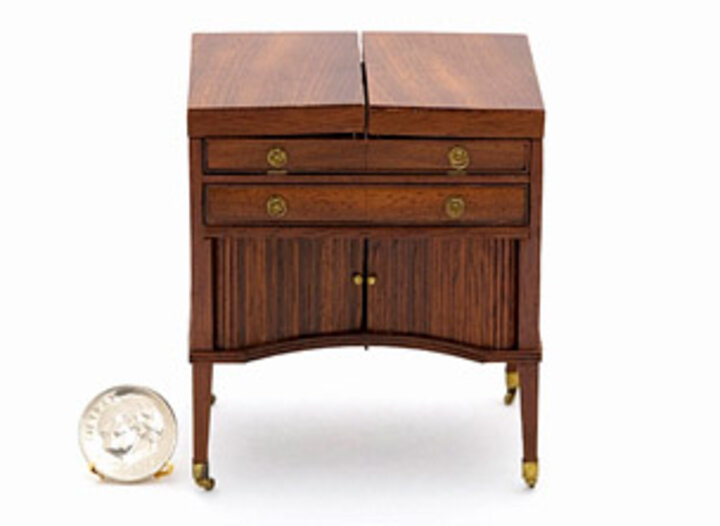


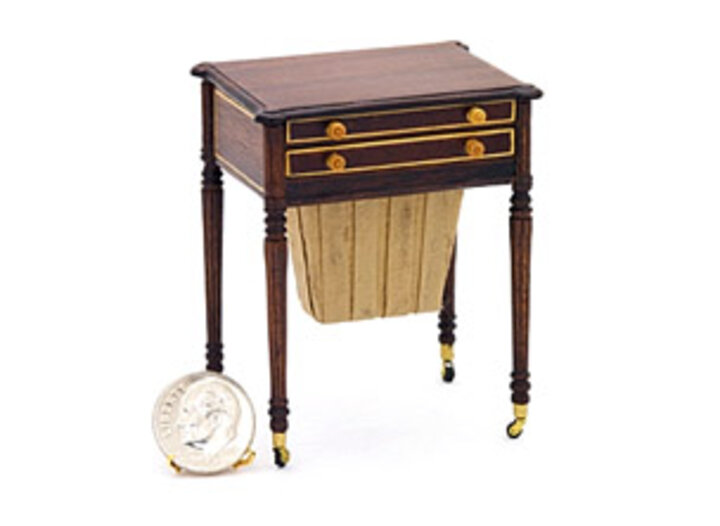
Rosewood Rococo Revival Center Table

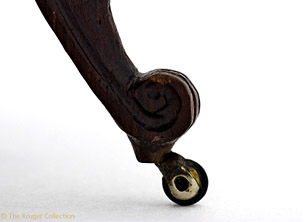

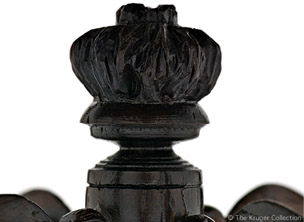
Details
c. 1840-1870
THOMAS A. WARNER
1977
rosewood
H 2 3/4 in. | D 3 1/4 in. H 6.985 cm | D 8.255 cm
1997.18e
Gift of the Eloise Kruger Charitable Trust
The era of Victorian Rococo Revival began in America circa 1840 and was displaced circa 1870 by the more angular Eastlake style. This elaborate scrolled and carved style of furniture derived directly from France with the immigration of Alexander Roux and Charles Boudouine. Originally in New York, the style spread across America and particularly into the South. Important makers succeeding Roux and Boudouine were John Henry Belter and Joseph Meeks, although the style is associated with the Belter name by the general public.
The artistry of Thomas A. Warner's carving is startling. The pierced grape and vine pattern and rose carvings on the apron and cabriole legs exhibit his skills beautifully. The stretchers support a carved bowl of fruit.
Regency Horseshoe Table
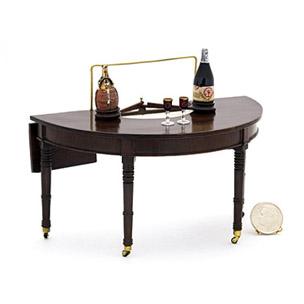
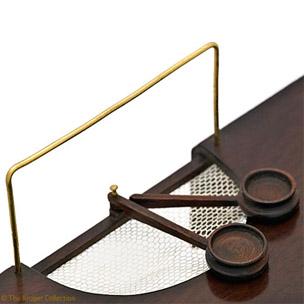
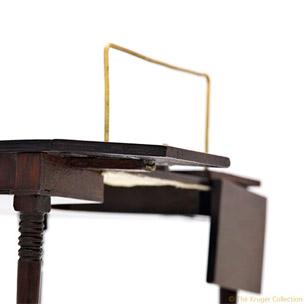
Details
c. 1810-1830
ERIC PEARSON
1963
mahogany, brass, netting, fabric tape
H 2 5/8 in. | W 5 in. | D 3 5/8 in.
H 6.668 cm | W 12.7 cm | D 9.208 cm
1997.340
Gift of the Eloise Kruger Charitable Trust
Also known as a Hunt Table, his horseshoe table represents a specialty table used for serving drinks. This design was an English form and was not found in the American colonies. When in use, the two leaves in the rear would be extended and the open ends placed in front of a fire. A curtain would be hung over the wire rod to protect the gentleman from the heat. White netting in the semi-circle of the table would hold biscuits, kept warm by the nearby fire, and the coasters held bottles that could be moved freely without damaging the tabletop.
Mahogany Louis XVI Game Table
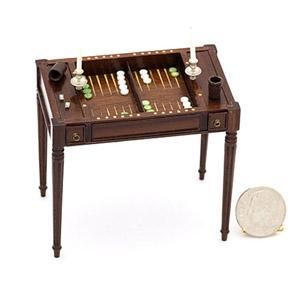
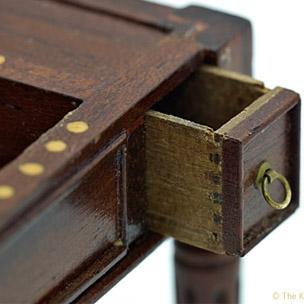
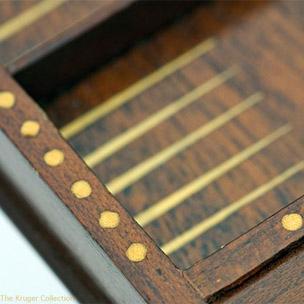
Details
c. 1780
ERIC PEARSON
1964
mahogany, inlaid wood, metal, ivory, leather
H 2 3/8 in. | W 2 1/2 in. | D 1 1/2 in.
H 6.033 cm | W 6.35 cm | D 3.15 cm
1997.334
Gift of the Eloise Kruger Charitable Trust
The backgammon table is an exceptional reproduction of a particular Louis XVI game table Eloise Kruger requested from Eric Pearson. The table has a lift-off top that shows a wood surface or can be flipped to show a green baize playing surface. When the lift-off top is removed, an inlaid backgammon board is revealed, along with ivory playing pieces, dice, and leather casting cups. Two candlesticks fit into pegs on the backgammon board for evening play. The two small dovetailed working drawers can contain the game pieces or candlesticks when the table is covered.
Mahogany Sheraton Butler's Desk
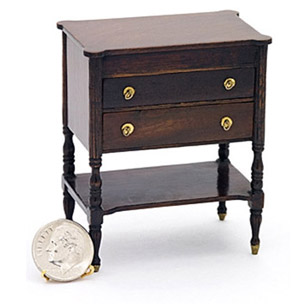
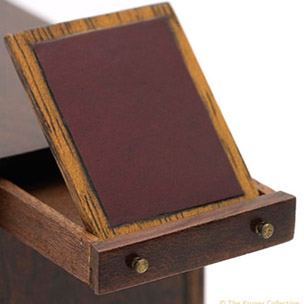
Details
Mahogany Sheraton Butler's Desk
c. 1823
ERIC PEARSON
1962
mahogany, leather
H 1 1/2 in. | W 2 1/8 in. | D 1 1/4 in.
H 6.35 cm | W 5.398 cm | D 3.175 cm
1997.356a
Gift of the Eloise Kruger Charitable Trust
Also referred to as a "lady's companion," this type of desk appears indiscriminate in a bedroom or living area.
The slide shelf on the side reveals a leather-covered reading and writing board. The hidden desk function gives it the moniker of a butler's desk, as these could be found within nightstands, chests of drawers, or dining sideboards.

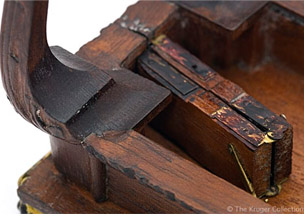
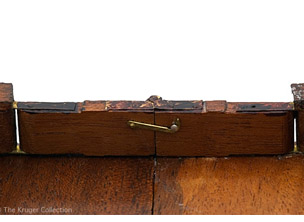
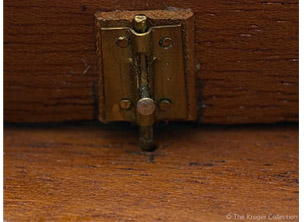
Details
Mahogany Chippendale Card Table
c. 1750-1790
ERIC PEARSON
1964
mahogany, suede, brass
H 2 1/2 in. | W 3 1/2 in. | D 3 1/2 in.
H 6.35 cm | W 8.89 cm | D 8.89 cm
1997.333
Gift of the Eloise Kruger Charitable Trust
Concertina-action folding tables have obvious advantages over the gate-leg style of table; there is always a leg at each corner whether the table is folded or extended. The method for constructing concertina-action tables is quite difficult and requires a master cabinetmaker's skill.
When Eloise Kruger wrote Eric Pearson that she would like one of these card tables, she didn't expect he could replicate the concertina-action in 1:12 scale, "I don't see how you can make a concertina this small, but it will not matter if it does not fold up. Have no intention of folding it" (Eloise Kruger to Eric Pearson, January 24, 1964). She was delighted when he replicated the table exactly, down to the concertina-action.
Mahogany Sheraton Gentleman's Dressing Table
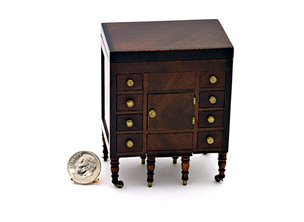
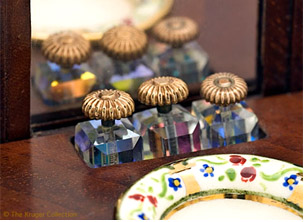
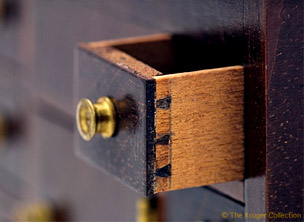

Details
Mahogany Sheraton Gentleman's Dressing Table, c. 1810-1820
ERNIE LEVY
1982 - mahogany, ivory, mirror, ceramic, glass
H 3 in. | W 2 3/8 in. | D 2 5/8 in.
H 7.62 cm | W 6.033 cm | D 6.668 cm
1997.342
Gift of the Eloise Kruger Charitable Trust
This style of dressing table was mainly an English design and rarely found in America.
It contains all the necessary accessories for grooming including a wash basin, cologne, shaving cups and slots for hair brushes, ceramic water flask, a lift mirror, and pull-out bidet. Eight drawers to store other personal items feature dovetailing.
Louis XV Inlaid Chiffonnier
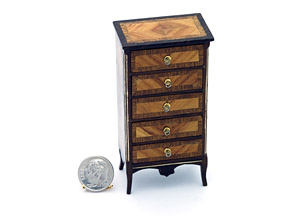
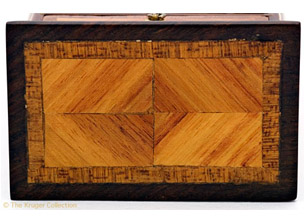
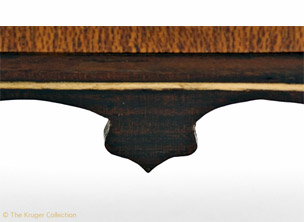
Details
Louis XV Inlaid Chiffonnier
c. 1730-1760
ERIC PEARSON
1963
rosewood, tulip wood, sapeli wood, holly wood, brass
H 3 1/4 in. | W 1 1/2 in. | D 1 in. H 8.255 cm |
W 3.81 cm | D 2.54 cm
1997.199
Gift of the Eloise Kruger Charitable Trust
Inlaid with three different woods as well as brass, this chest of drawers perfectly exhibits the opulence of the French design. Quartered veneer and mahogany cross-banding provide gorgeous color and texture without the need for ornamentation.
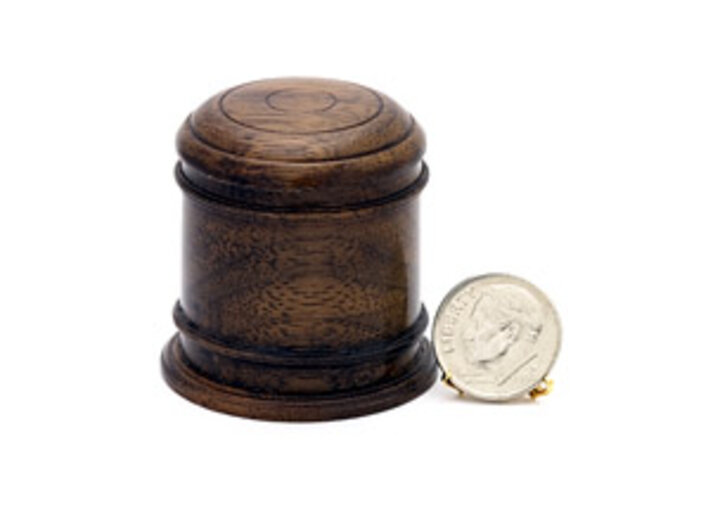
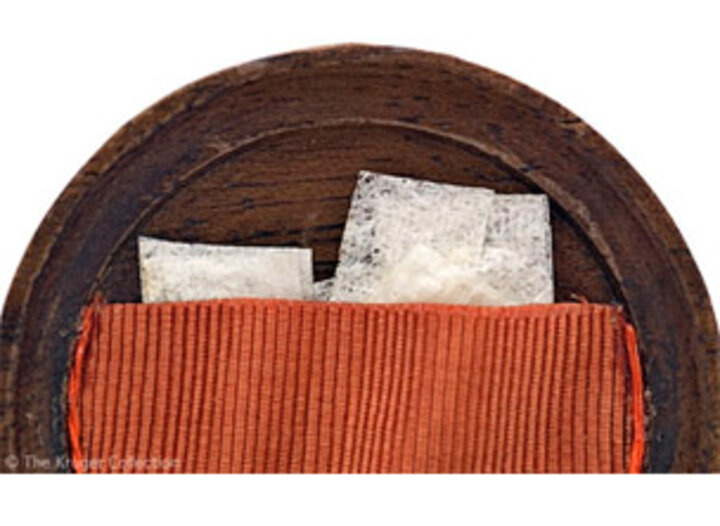
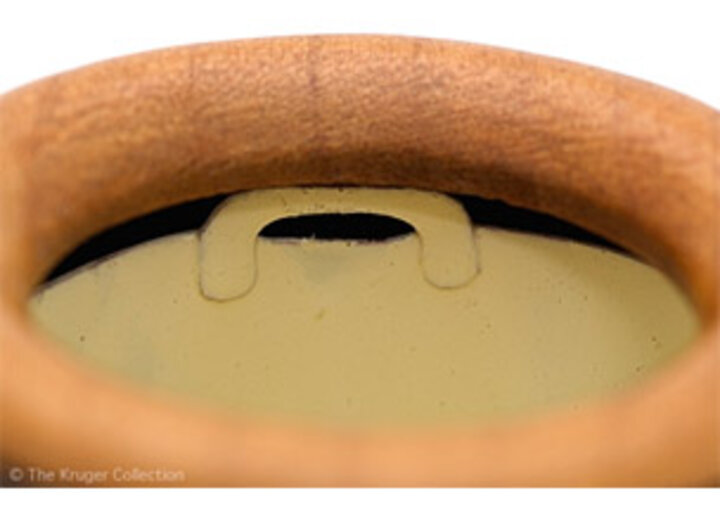
Details
Victorian Cylindrical Commode
c. 1875-1905
ERIC PEARSON
1967
walnut, maple, textile, paper
H 1 1/2 in. | D 1 1/2 in.
H 3.81 cm | D 3.81 cm
1997.183
Gift of the Eloise Kruger Charitable Trust
Eloise Kruger saw a full-sized version of this commode in an historic home in Brownville, Nebraska. She immediately sketched the piece, made note of its dimensions, and wrote to her favorite miniature artisan, Eric Pearson.
In his correspondence, Mr. Pearson lightheartedly nicknamed the piece the "Barber's Music Box," and Ms. Kruger had noted the considerable amount of embarrassment she went through in describing the various parts of the commode in her instructions to Pearson.
The maple seat can be removed in order to retrieve the two-handled pot within. The fabric pouch under the lid holds toilet tissue. This type of commode was mass produced in Philadelphia by The Hale and Kilburn Company between 1875 and 1905.
Federal Style Dueling Pistols
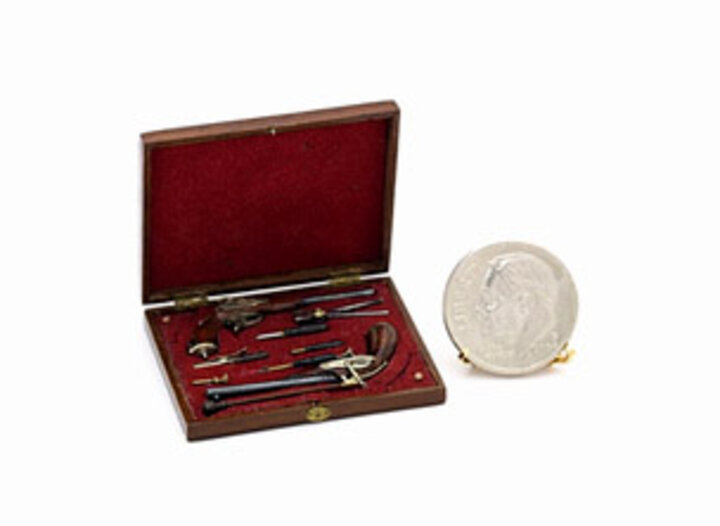
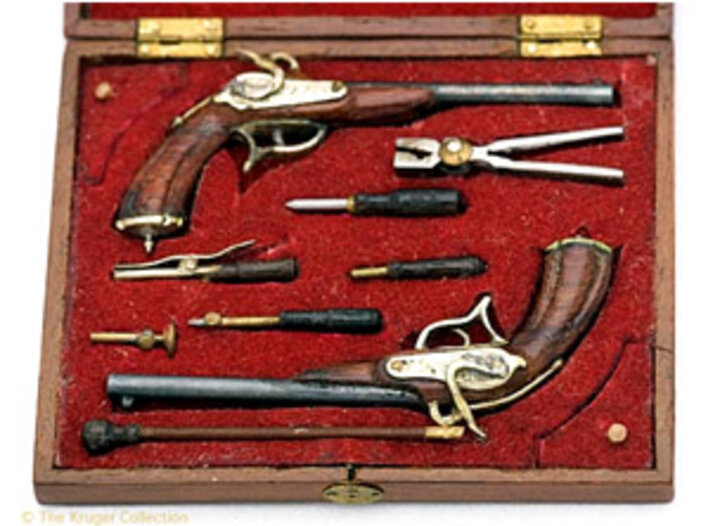
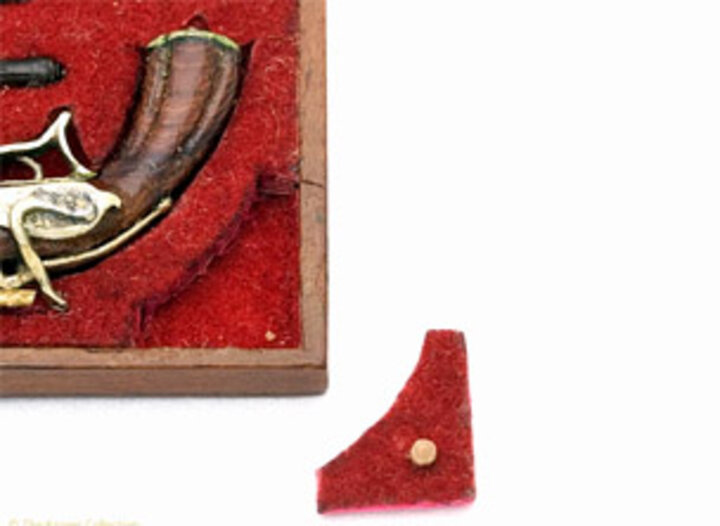
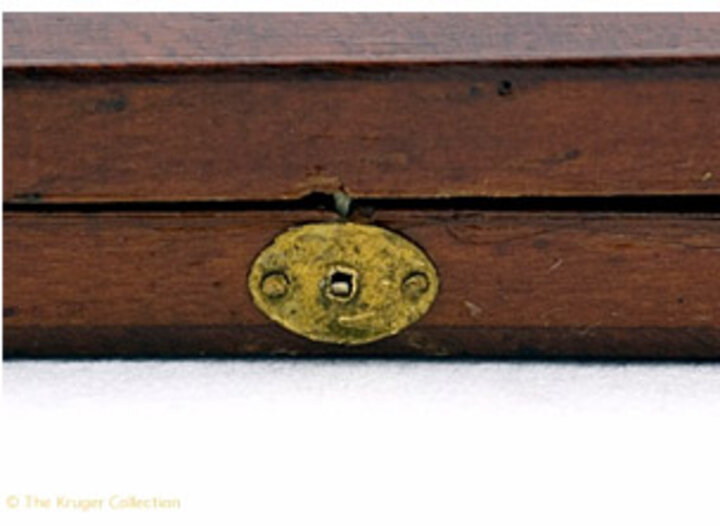
Details
c. 1800-1810
ERIC PEARSON
1964
mahogany, velvet, brass, metal
H 1/4 in. | W 1 3/8 in. | D 1 1/8 in.
H .635 cm | W 3.492 cm | D 2.858 cm
1997.990
Gift of the Eloise Kruger Charitable Trust
When Eloise Kruger mentioned to Eric Pearson that the gentleman in her 18th century southern parlor needed a set of dueling pistols, Mr. Pearson surprised her with this set.
Each item is removable from the mahogany case, and the set includes a working bullet mould, rods for cleaning the guns and ammunition cases at the corners.
Ms. Kruger and her husband were thrilled when she received the dueling pistols by post. She wrote to Mr. Pearson, "We keep going back to look at it again, which is dangerous. We both caught horrible colds in Chicago and if either of us should sneeze, all would be lost. It is completely fabulous."
Mahogany Chippendale Kettle Stand

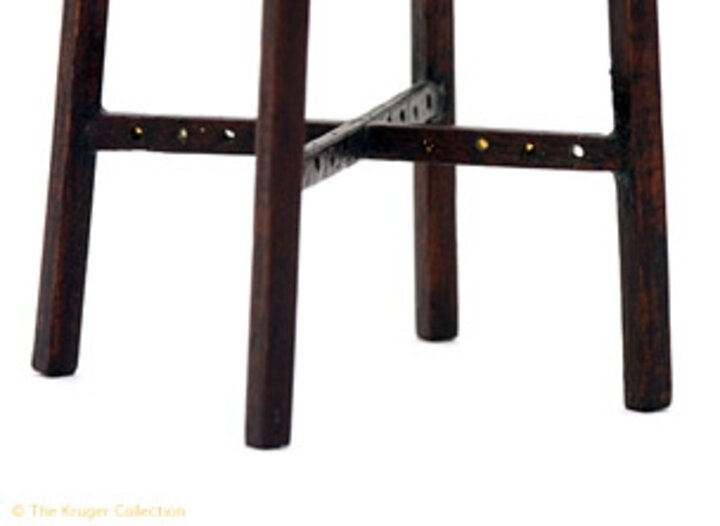

Details
c. 1780-1790
ERIC PEARSON
1962
mahogany, brass
H 2 1/4 in. | W 1 in. | D 1 in.
H 5.715 cm | W 2.54 cm | D 2.54 cm
1997.359
Gift of the Eloise Kruger Charitable Trust
Eloise Kruger commissioned this kettle stand, or urn stand, from Eric Pearson based on a clipping she sent him of an Irish urn stand.
The table is large enough to hold little more than a hot kettle, keeping it safely off other surfaces as tea is served. Most kettle stands contained a pull out slide such as this one, which could be used to place your cup as the hot tea is poured.
Mahogany Early Georgian Reading Chair
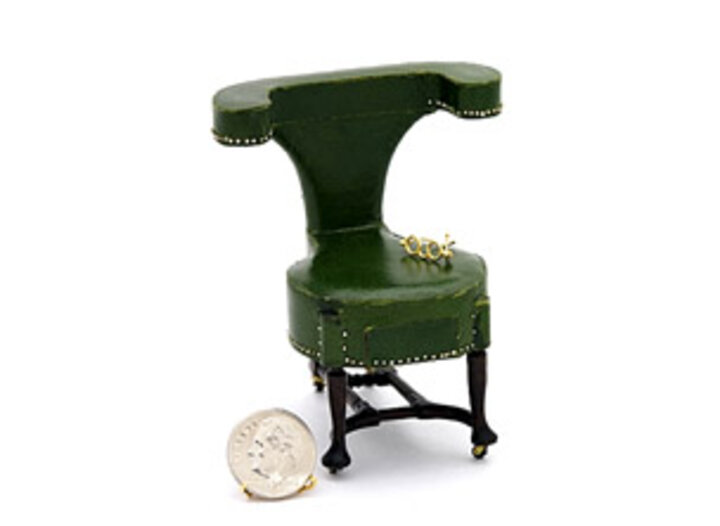
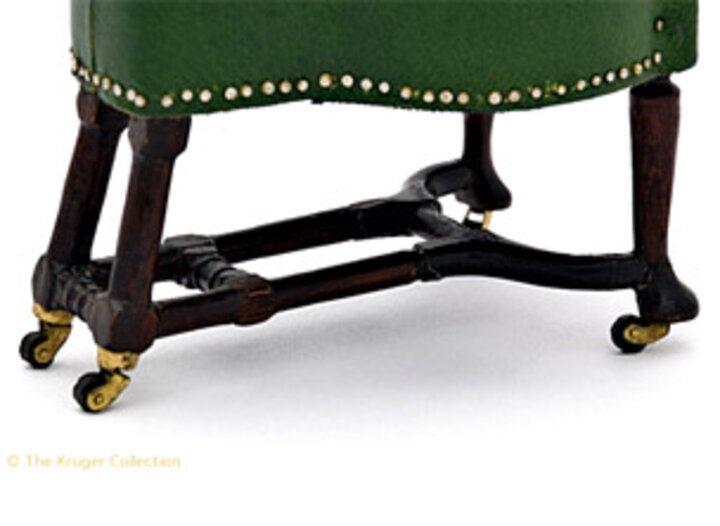

Details
c. 1755-1790
ERIC PEARSON
1964
leather, mahogany, porcelain, brass
H 2 7/8 in. | W 2 3/8 in. | D 2 in.
H 7.303 cm | W 6.033 cm | D 5.08 cm
1997.157
Gift of the Eloise Kruger Charitable Trust
This gentleman's reading chair and other straddle chairs of similar fashion were popular in mid 18th century England. Some also contained a pull-out book rest at the head of the chair or pull-out candle holders at the chair arms.
The drawer featured in this chair seat could be used to contain a book, spectacles, writing implements, or any other devices related to the chair's purpose. This one contains a shallow porcelain bowl
Eloise Kruger commissioned miniature artist Eric Pearson in 1963 to reproduce this chair from an illustration in F. Lewis Hinckley's A Directory of Antique Furniture (New York: Bonanza Books, 1953).
She planned this piece for her gentleman's library, composed of other Pearson pieces including a breakfront bookcase, library steps, leather-paneled pedestal desk, and architect's table.
Linen Press


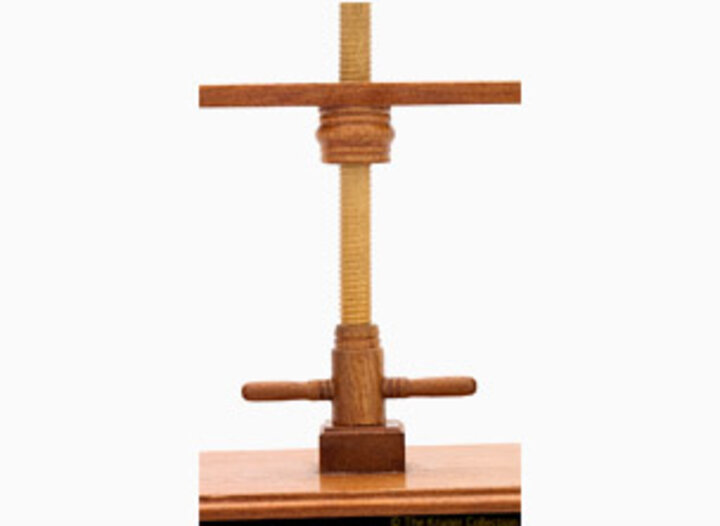
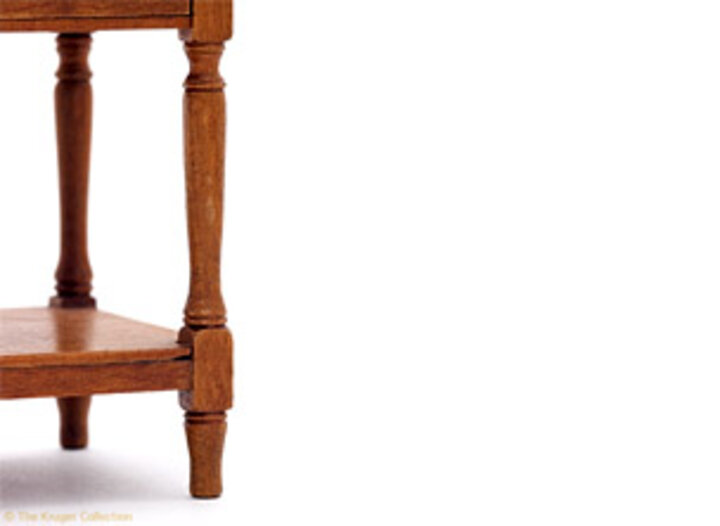
Details
Linen Press
ERIC PEARSON
1966
cherry wood
H 5 1/8 in. | W 2 5/8 in. | D 1 3/4 in.
H 13.018 cm | W 6.668 cm | D 4.445 cm
1997.413
Gift of the Eloise Kruger Charitable Trust
This linen press was one of the many unique items Ms. Kruger commissioned Eric Pearson for. She writes in a letter dated April 2, 1966:
"This is actually a printed picture press, but the linen presses were made exactly the same, except that the board which presses down was thicker. There were many versions, some on chests of drawers and some to set free on top of a storage lidded chest, but neither of these makes sense to me, and I think my ancestresses would prefer this version, where each pile of pressed sheets could be put directly below on the shelf, little pieces in the drawer."
Rosewood and Mahogany Spinet
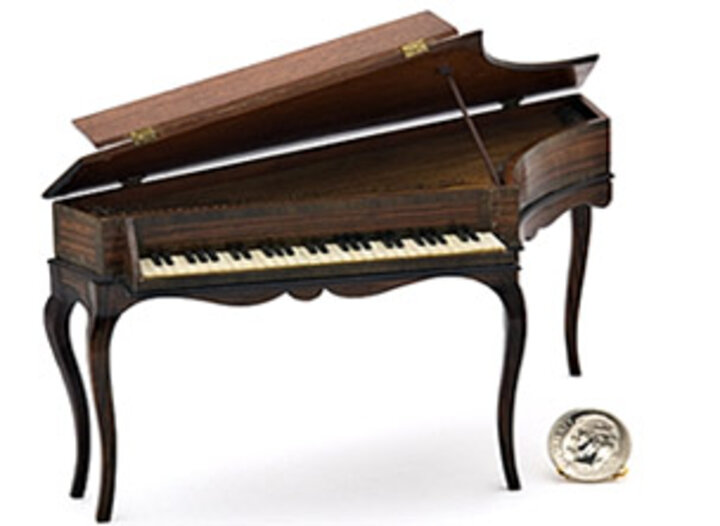
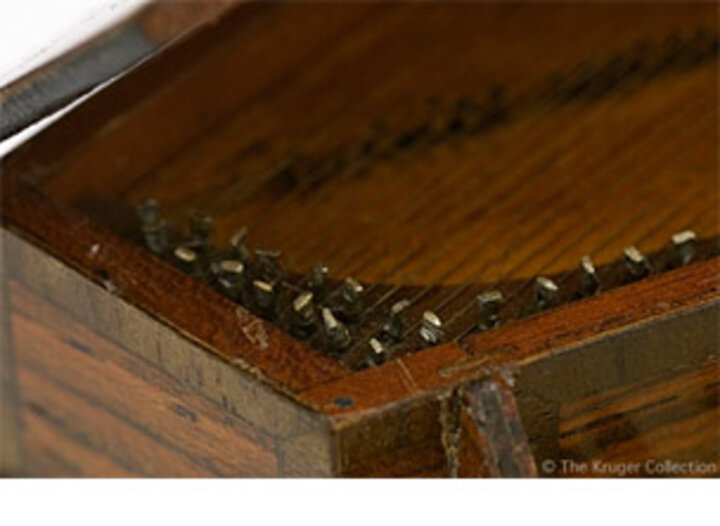
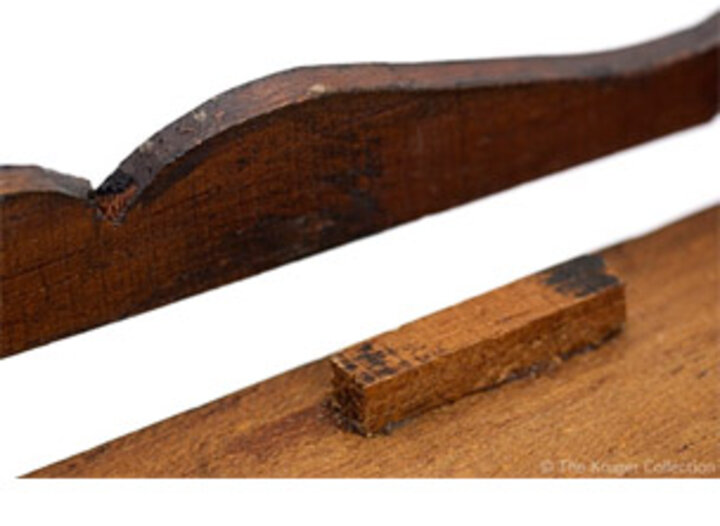
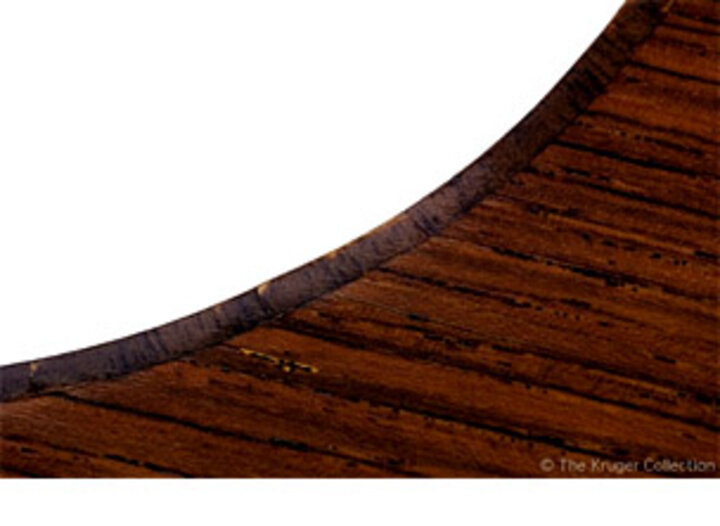
Details
Rosewood and Mahogany Spinet
c. 1722-1774
ERIC PEARSON
1964 - rosewood, mahogany, ivory, ebony, brass
H 3 1/8 in. | W 5 3/4 in. | D 2 3/4 in.
H 7.938 cm | W 14.605 cm | D 6.985 cm
1997.232a
Gift of the Eloise Kruger Charitable Trust
A spinet is closely related to the virginal in the harpsichord family, but it is strung diagonally and is wing-shaped rather than square. Italian in origin, these instruments were particularly popular in England during the 17th and 18th centuries.
The instrument would be made in England and shipped to the purchaser, where the base would be made separately after its arrival in the American colonies.
Eric Pearson was commissioned to craft this Louis XV-style spinet Eloise Kruger identified in one of her many furniture directory reference books.
Mr. Pearson cautioned Eloise Kruger not to touch the spinet's strings. They are .003 inches in diameter and are extremely fragile.
The rosewood spinet features mahogany banding, and the instrument and legs are separate pieces, maintaining the historical accuracy of the miniature.
Walnut Paneled Settee

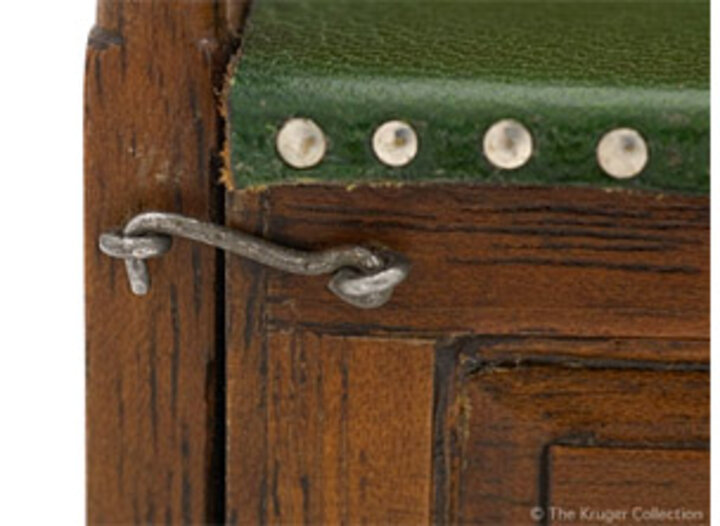
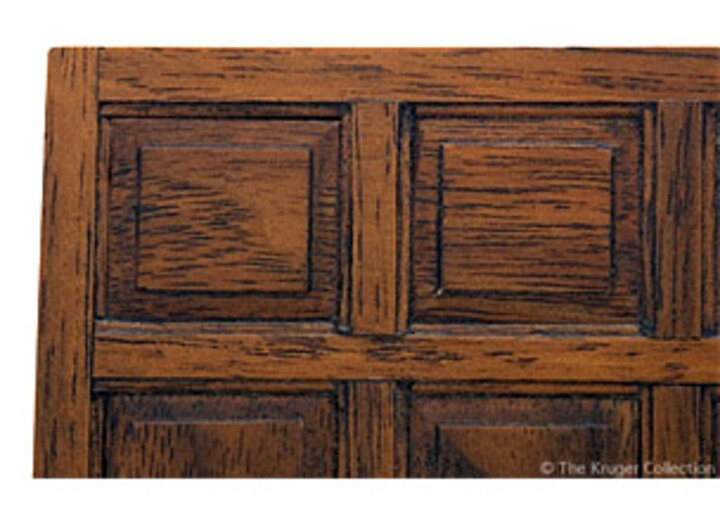
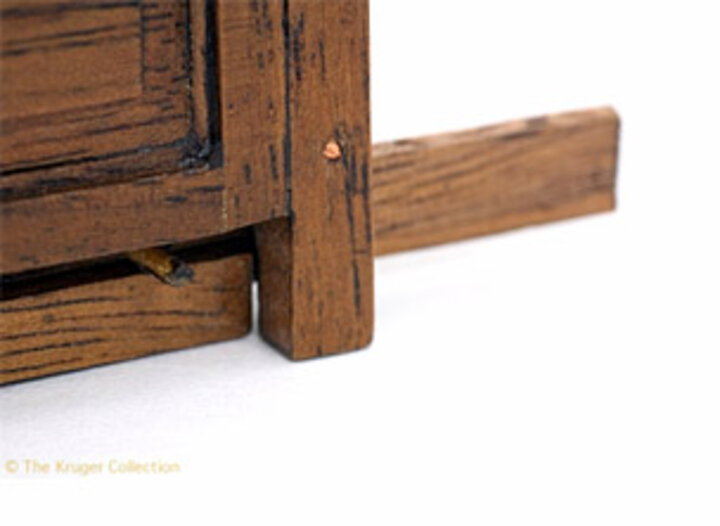
Supportive Sliding Floor Rest
Details
Walnut Paneled Settee
c. 1700-1750
ERIC PEARSON
1965
walnut, leather, metal
H 4 1/8 in. | W 6 1/8 in. | D 2 1/4 in.
H 10.478 cm | W 15.558 cm | D 5.715 cm
1997.277
Gift of the Eloise Kruger Charitable Trust
The pull-out bed is an old invention, as this settee/bed from the early 1700s proves. Eloise Kruger commissioned this settee from Eric Pearson based on one pictured in Wallace Nutting's Furniture Treasury
(New York: Macmillan Company, 1961. Fig. #1634).
Two small metal latches on the front panel secure the piece as a settee. To fold out into a bed, the floor rests slide out using the handles on each side, the latches unhook, and the seat folds outward. Once extended, it can be filled with cushions to accommodate its user.
Shaker Tailoring Counter
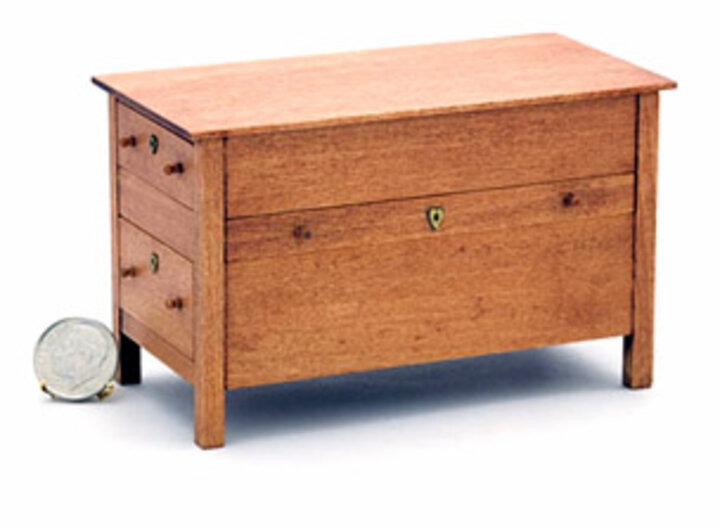
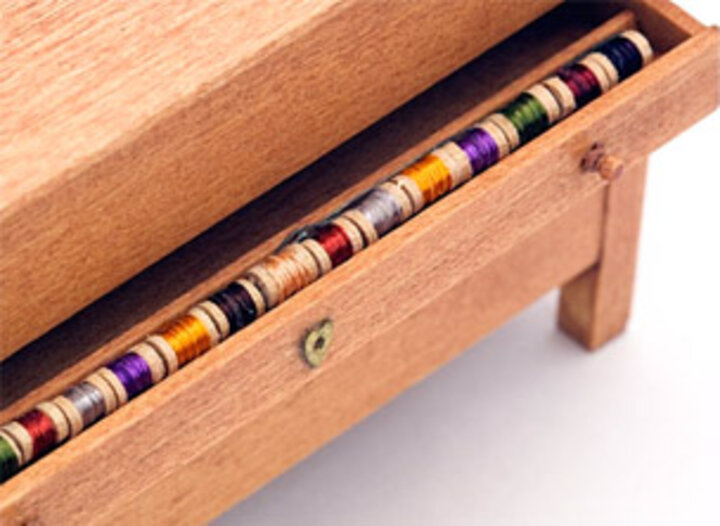
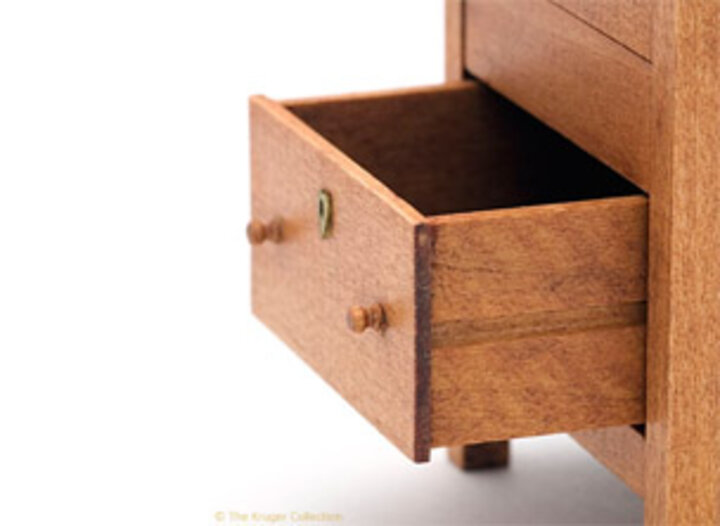
Details
c. 1830
PAUL E. ROULEAU
1978
cherry, brass
H 2 9/16 in. | W 4 1/4 in. | D 2 3/16
H 6.509 cm | W 10.795 cm | D 5.556 cm
1997.215
Gift of the Eloise Kruger Charitable Trust
Tailoring was a valued trade in Shaker communities, and this design is a copy of a tailoring counter found in East Chatham, New York.
The front drawer containing several spools of colored thread spans the entire depth of the piece, and each side drawer extends to half the width of the counter.
This particular design allows for the greatest amount of usable drawer space.
Walnut Chippendale Spice Chest

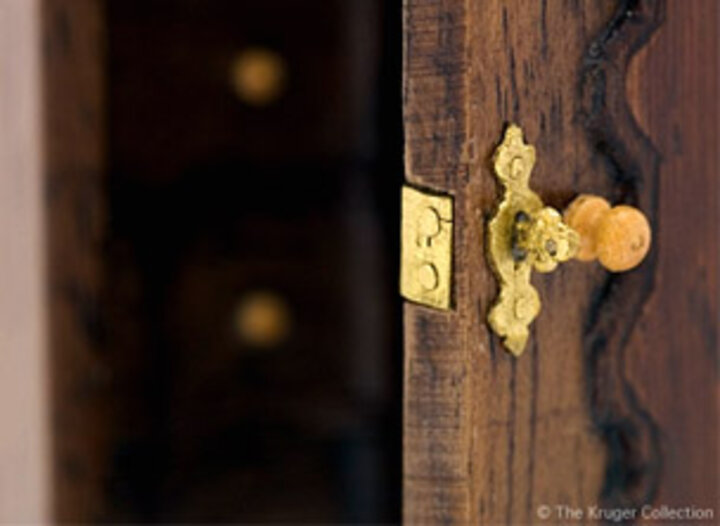
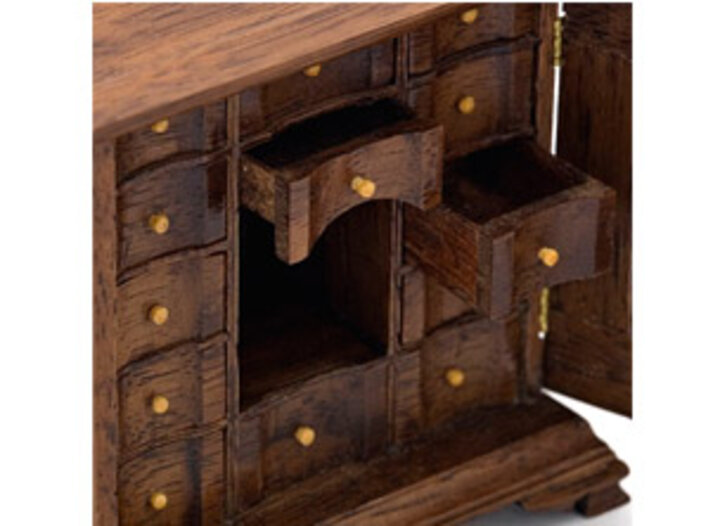
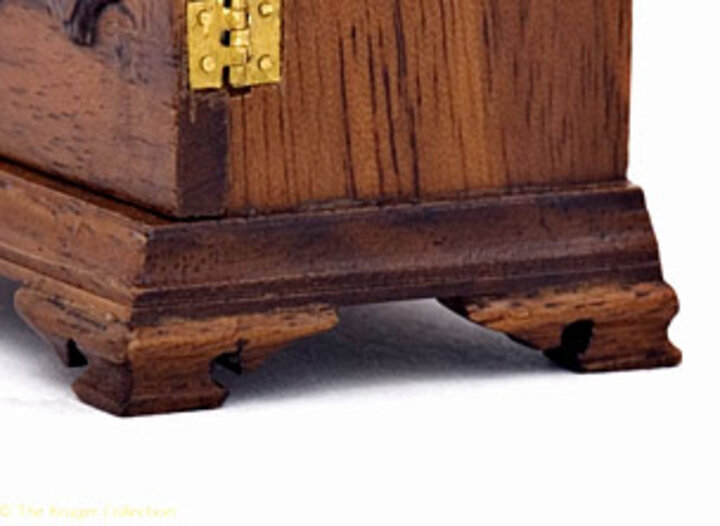
Details
Walnut Chippendale Spice Chest
c. 1750-1790
ERIC PEARSON
1967
walnut, brass, rosewood
H 2 in. | W 2 1/4 in. | D 1 1/8 in.
H 5.08 cm | W 5.715 cm | D 2.858 cm
1997.61
Gift of the Eloise Kruger Charitable Trust
Spice chests were quite common, although this design is particularly remarkable in that it contains a hinged door with working lock and key. Spices would be kept loose in the thirteen block and cove-molded drawers, and access to the valuable spices was restricted by the locking door.
Eloise Kruger commissioned this spice chest from Eric Pearson and wrote to him of her delight upon its arrival:
"I raced [my husband] Carl to get it unpacked, and while I was petting that gorgeous inlaid commode and the unique bombe chest, Carl was losing his mind over the spice chest. He always has to try every tiny drawer, while I yell at him to be careful."
Mahogany Hepplewhite Tambour Writing Table
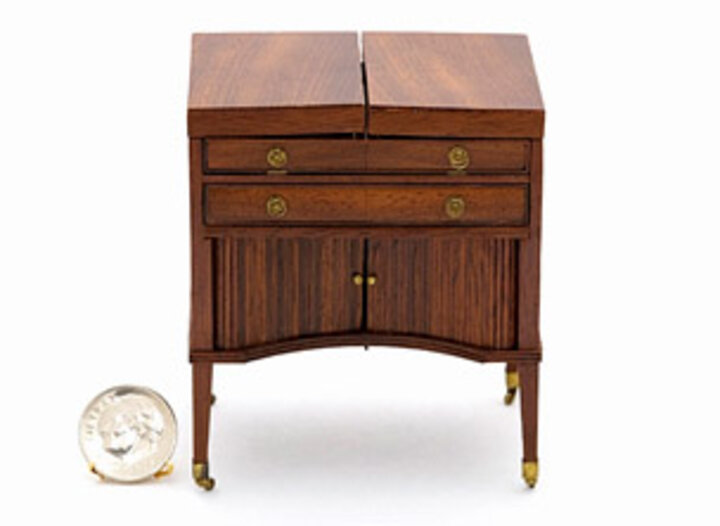

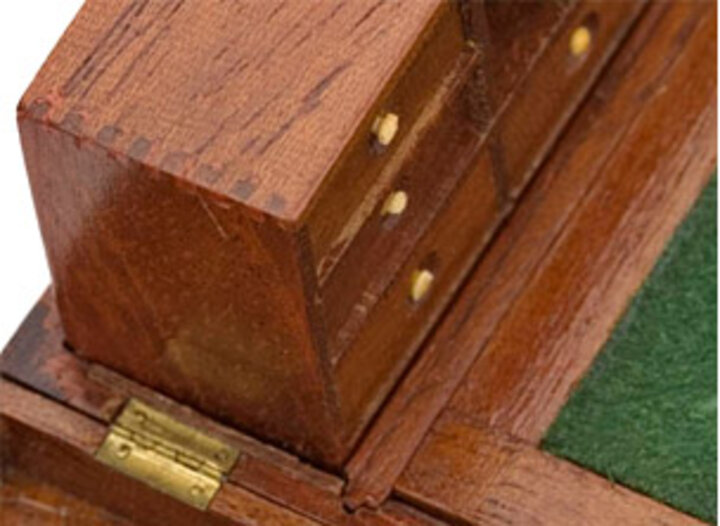
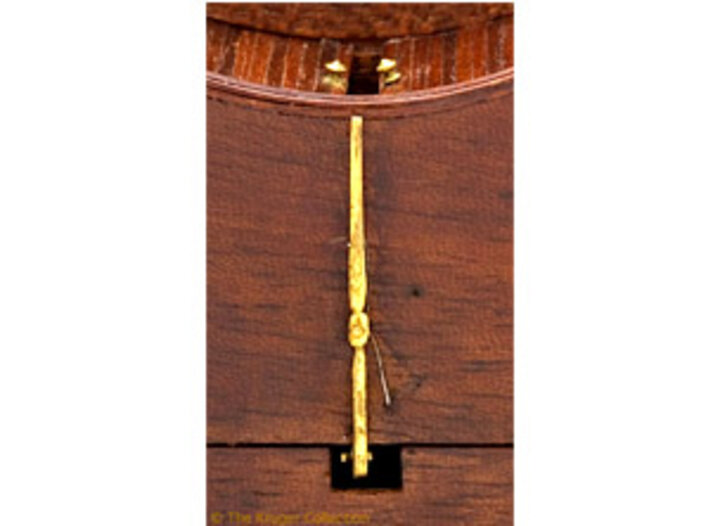
Details
Mahogany Hepplewhite Tambour Writing Table c. 1790-1800
A. REEVES
1967
mahogany, textiles, mirror, brass
H 2 7/8 in. | W 2 1/2 in. | D 1 3/4 in.
H 7.303 cm | W 6.35 cm | D 4.445 cm
1997.343
Gift of the Eloise Kruger Charitable Trust
This exquisite writing table features folding box lids, a mechanical component on the bottom to operate the rising pigeonhole carriage, and writing pad that tilts to accommodate the writer.
The lower drawer contains several compartments to store a gentleman's personal accoutrements, and a mirror that rises to double as a dressing table.
The tambour doors are moveable, and the dovetailing on the pigeonhole drawer carriage mark this as a true master's work.
Eloise Kruger purchased this piece from Eric Pearson's personal collection. Mr. Pearson included instructions on how to handle the delicate piece.
Mahogany George III Tilt-top Supper Table
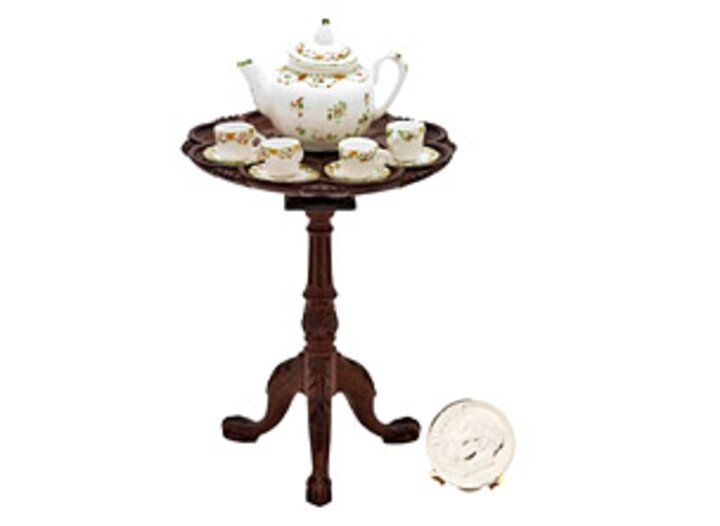
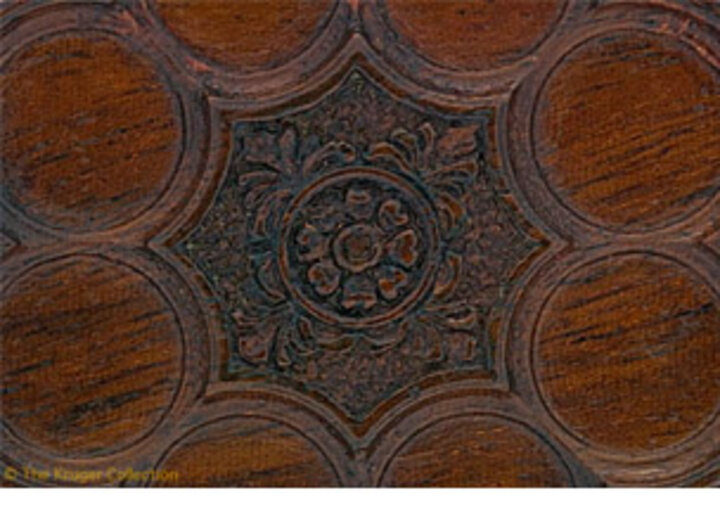
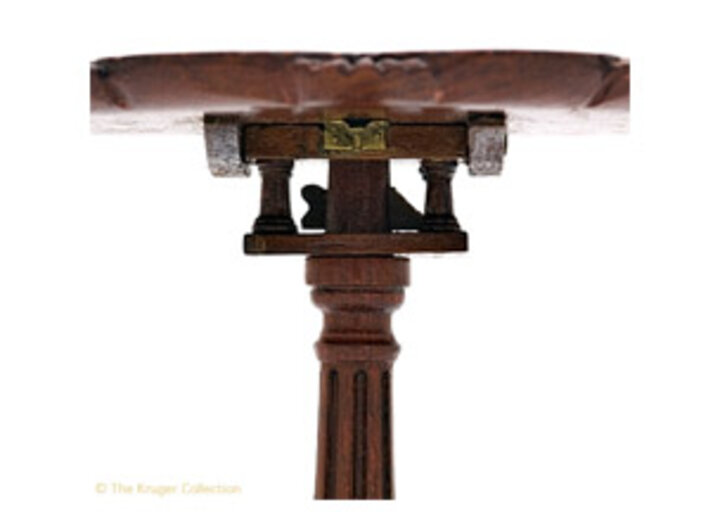
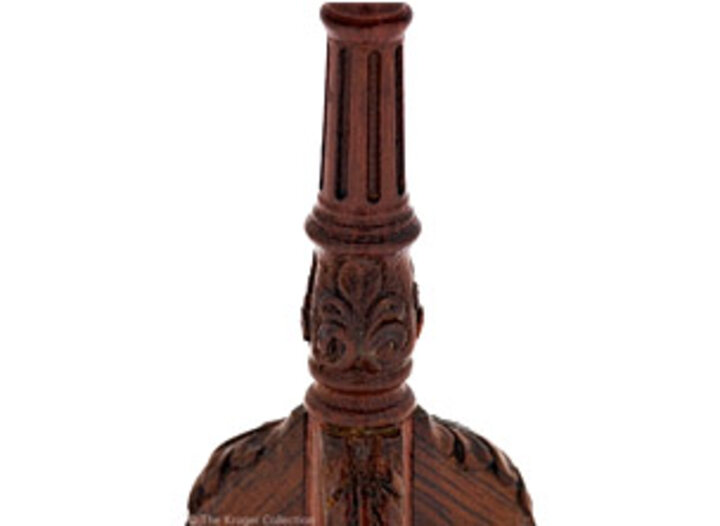
Details
c. 1740-1750
ERIC PEARSON
1966
mahogany, brass
H 2 1/2 in. | D 2 1/8 in.
H 6.35 cm | D 5.398 cm
1997.376
Gift of the Eloise Kruger Charitable Trust
This tilt-top supper table is done in the style of Abraham Roentgen. Roentgen was born in Germany but earned his fame working in England where he was admired for his inventive use of mechanical fittings, fine marquetry work, and creatively hidden drawers.
The table contains eight carved plate holders surrounding a beautiful carved foliate design. A working brass latch holds the table in the horizontal position, and it can be tilted up and compactly stored in a room's corner when not in use.
Every centimeter of this table is a tribute to miniature artist Eric Pearson's carving skills; the center foliate design, plate holders, fluted pedestal, acanthus-carved knees on the cabriole legs, and ball and claw feet.
Mahogany Sheraton Chess Table
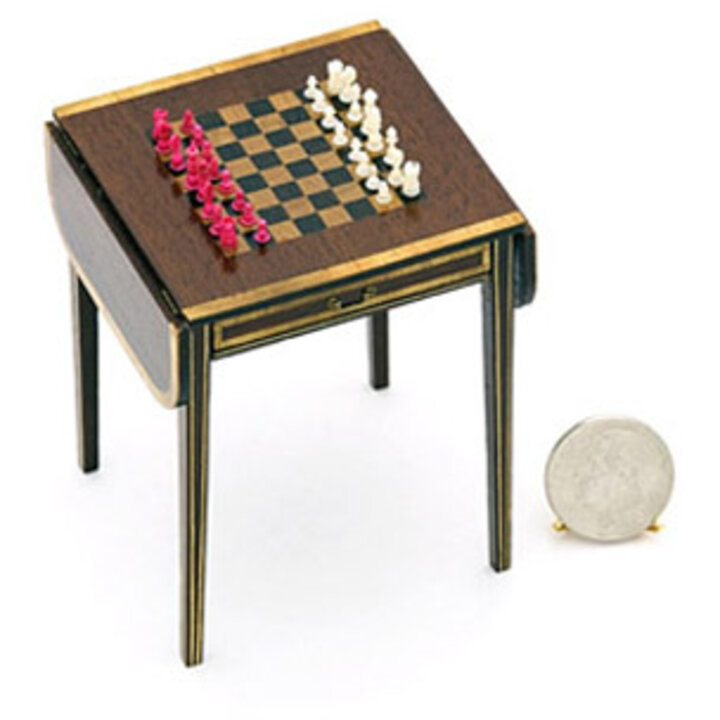

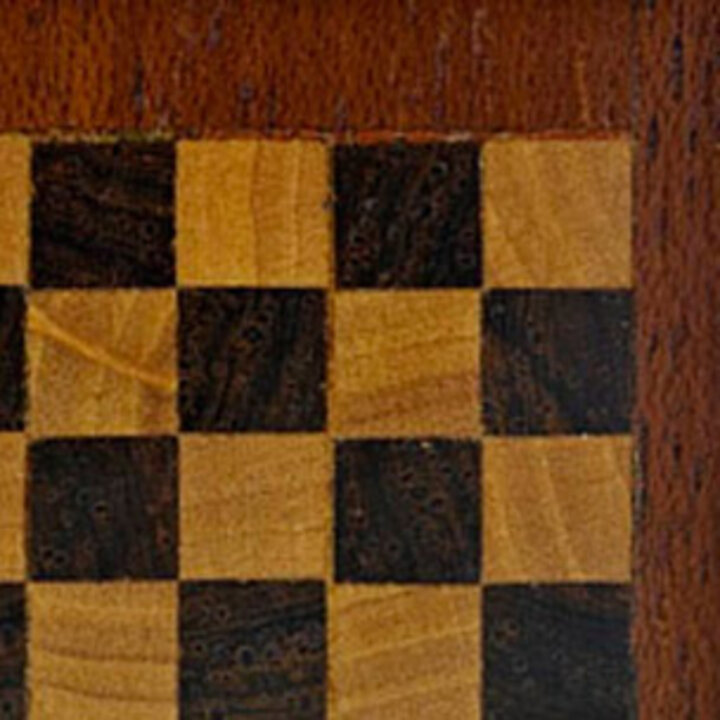
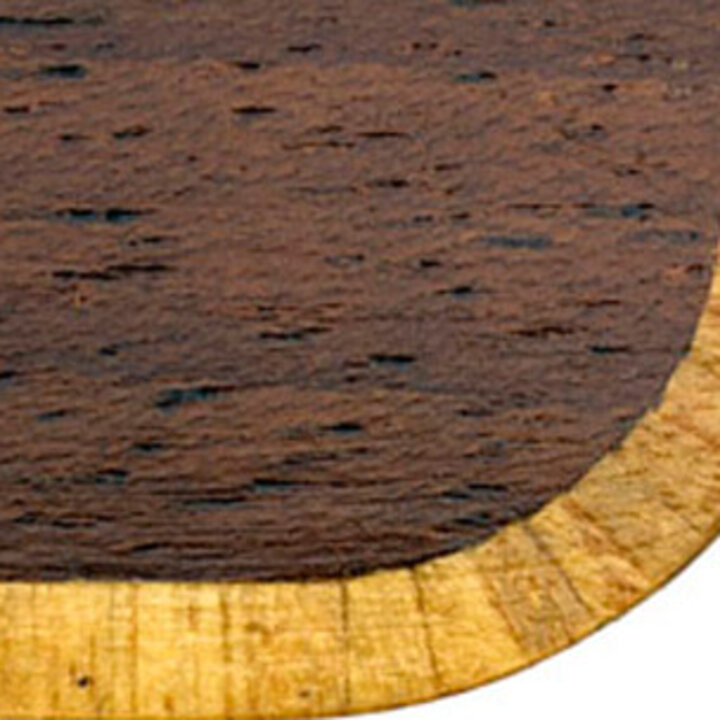
Details
Mahogany Sheraton Chess Table
c. 1790-1810
ERIC PEARSON
1964 - mahogany, satinwood, ebony, ivory, velvet, brass
H 2 1/2 in. | W 2 in. | D 1 7/8 in.
H 6.35 cm | W 5.08 cm | D 4.763 cm
1997.335
Gift of the Eloise Kruger Charitable Trust
This chess table was commissioned by Eloise Kruger through photographs she supplied to artist Eric Pearson. The table features drop leaves with butterfly hinges and an inlaid satinwood and ebony game board.
The working drawer features a green velvet-lined divided drawer to house the 16 red and 16 white carved ivory chess pieces - the king piece is the tallest standing 5/16 of an inch high.
Eloise Kruger was astonished when she opened the drawer to reveal the tiny chessmen and wrote to Mr. Pearson in a letter dated May 9, 1964, "If I should sneeze or even breathe heavily, I'd spend the next two years on the floor with a magnifying glass looking for the chessmen."
Mahogany Sheraton Work Table
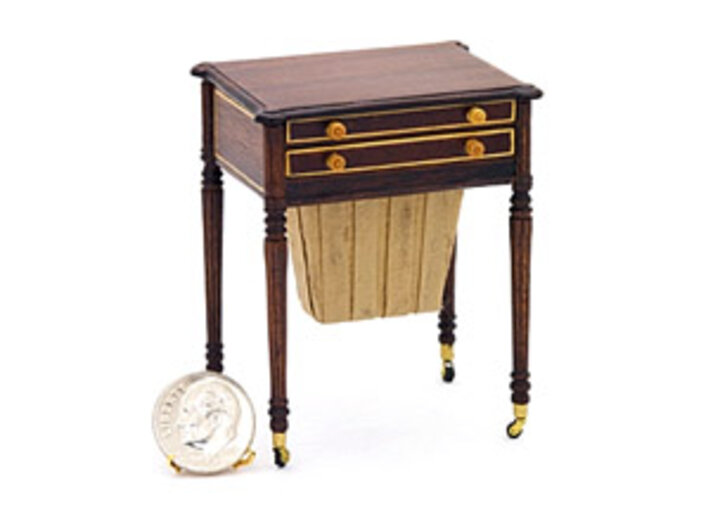

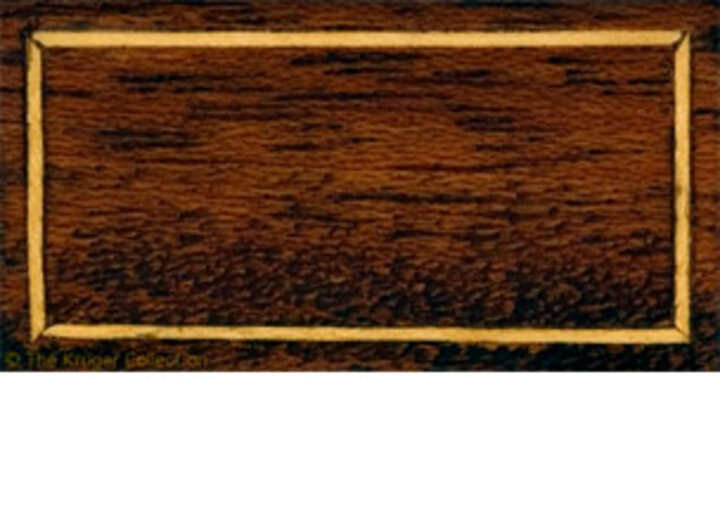
Details
Mahogany Sheraton Work Table
c. 1790-1800
ERIC PEARSON
1963
mahogany, satin ribbon, brass
H 2 1/2 in. | W 2 in. | D 1 1/2 in.
H 6.35 cm | W 5.08 cm | D 3.81 cm
1997.349
Gift of the Eloise Kruger Charitable Trust
Work tables of this era, also known as a "ladies' work table," came in many designs and were quite popular beginning with the Federal period (c. 1780).
This work table features two working drawers for supplies and a slide out sewing basket. Casters allow the piece to be conveniently stored in the periphery of a room when not in use.
Miniature artisan Eric Pearson's skill at exceptional detail is evident in the turned and reeded legs and the brass inlay molding around the drawers and table sides.